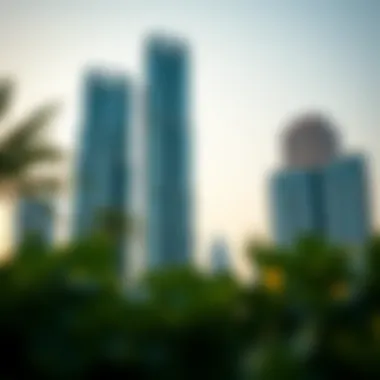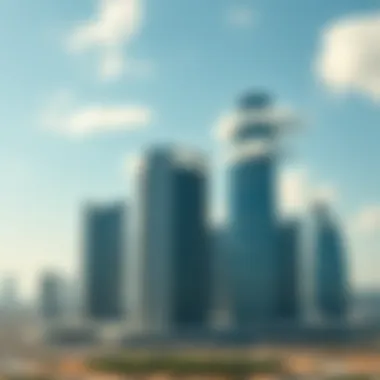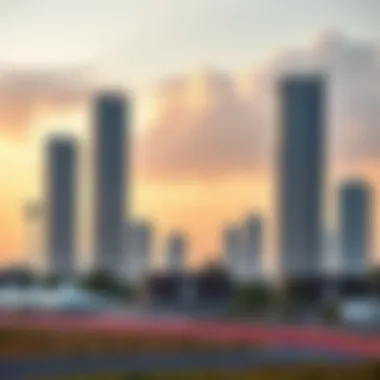Exploring Cloud Towers in Dubai's Real Estate Scene


Intro
Dubai’s skyline is a testament to architectural ambition, dotted with structures that reach towards the heavens. Amongst this innovative landscape, the concept of cloud towers emerges as a beacon of creativity and sophisticated engineering. These towering edifices do not just alter the view of the city but also redefine urban living itself.
As this article will delve deeper into, cloud towers blend design with sustainability, presenting an enticing proposition for potential investors and residents alike. In understanding these structures, one can grasp their significance in a city that rarely rests on its laurels when it comes to development and luxury. Each cloud tower represents not just physical space but also an idea—of a future where ecological responsibility meets opulent living.
From breaking through the challenges of design and engineering to assessing the possible investment opportunities, this article aims to provide a robust overview of what makes cloud towers a noteworthy topic in Dubai’s real estate dialogue. Let's navigate through these enticing structures and their broader implications in an ever-evolving urban landscape.
Market Trends
Current Market Analysis
In recent years, Dubai has witnessed an impressive spike in real estate investments, especially in unique architectural projects like cloud towers. As urban populations rise and the demand for high-quality living spaces increases, developers are focusing on innovative designs that promise both luxury and sustainability.
The cloud towers are being marketed as more than just residential or commercial spaces. They embody a cultural shift towards sustainability. Since climate issues are at the forefront of discussions worldwide, these towers integrate green technologies, energy-efficient systems, and eco-friendly materials into their designs, following the city's commitment to a sustainable future.
Here are some key statistics regarding the current market:
- Increased Foreign Investment: In 2022, Dubai attracted nearly 40% more international investors in real estate compared to the previous year, signaling strong global confidence in the emirate's market.
- Rising Demand for Premium Properties: Post-pandemic, the preference for larger residential units has grown, with cloud towers often fitting the bill for their spacious layouts and modern amenities.
Future Predictions
Predicting future trends in real estate can be tricky, but one can certainly observe some patterns pertinent to cloud towers. As innovations in building materials and technologies continue to advance, it is expected that the next generation of cloud towers will integrate even more cutting-edge features, such as:
- Smart Home Technologies: Increased demand for smart home integration in living and working spaces.
- Community-Centric Structures: Focus on creating shared spaces that foster community engagement and wellness.
Experts predict that by 2030, cloud towers might not just be residences but could evolve into vibrant ecosystems, composed of mixed-use environments hosting shops, offices, parks, and communal spaces—all working in harmony with the natural landscape around them.
This ongoing evolution reflects Dubai's broader goals of fostering innovation while addressing the pressing challenges of urbanization and climate change, all wrapped in a package of luxury and style.
Property Investment Insights
Types of Investment Properties
When looking at cloud towers as investment opportunities, it’s important to identify the type of properties that may yield the best returns. Options include:
- Residential Units: The growing demand for luxury apartments in cloud towers can provide lucrative rental incomes.
- Commercial Spaces: With many cloud towers designed to house retail shops and offices, investing in these units can bring consistent revenue streams.
- Mixed-use Developments: These projects are the bread and butter of investing in modern urban settings, allowing for diverse income possibilities from various tenants.
Financing Options and Tips
Navigating the financial landscape of investing in cloud towers requires strategic insight and planning. A few tips include:
- Secure Pre-Approval: Before diving into the market, ensure your financing is lined up to leverage the best opportunities quickly.
- Understand the Market: Familiarize yourself not only with the pricing trends but also with the financial health of developers.
- Consult with Experts: Engaging with real estate agents or consultants who have experience in Dubai's market can yield valuable insights, ensuring your investment aligns with larger market movements.
The intricate dance of economy, design, and sustainable practice is what makes cloud towers an exciting focal point in Dubai’s real estate realm. Thus, as we move forward, the perspectives shared in this article will empower prospective investors and residents to navigate this evolving landscape with a clearer direction—a necessary guide in what can often feel like a labyrinth of opportunities.
Preface to Cloud Towers
The concept of cloud towers represents a transformative shift in Dubai's real estate landscape, capturing the imaginations of investors, urban planners, and residents alike. As cities around the world grapple with the challenges of space, sustainability, and functionality, Dubai has positioned itself at the forefront by adopting innovative architectural approaches. Cloud towers fit snugly into this narrative, embodying both elegance and practicality.
Defining Cloud Towers
Defining cloud towers requires more than just a glance at their physical structure. These towers, often characterized by their vertical designs that soar into the sky, create a dual experience of luxury living and breathtaking vistas. They often feature amenities that promote a community feel while retaining a modern aesthetic.
In essence, a cloud tower is not just a place to live; it’s a lifestyle choice. With features like lush rooftop gardens, indoor recreational spaces, and panoramic views, they cater to the affluent who value both convenience and style in their daily lives. Think of them as vertical neighborhoods where horizontal limitations are overcome, allowing for a blend of social opportunities and private retreats.
Origin and Evolution
The idea of cloud towers is deeply rooted in Dubai's relentless pursuit of architectural excellence. Initially, the concept was incubated as an answer to the growing demand for luxury real estate amid a rapidly expanding population. Over the years, cloud towers have evolved from simple high-rise designs into sophisticated structures equipped with cutting-edge technology and sustainable practices.
These towers began popping up on the horizon in the late 2000s, spurred on by the global trend of urbanization and a burgeoning middle class looking for modern housing solutions. Dubai's vision, fueled by a blend of innovation and a thirst for prestige, has allowed cloud towers to flourish. Today, they stand as beacons of aspiration—reminders that in a city where the sky is not the limit, architectural dreams can touch the clouds.
"Cloud towers symbolize not just luxury, but a forward-thinking approach to urban living, integrating functionality with aesthetics."
In summation, the inception and growth of cloud towers in Dubai represent a fascinating intersection of ambition and necessity, offering a glimpse into the future of urban living and investment opportunities. This article will delve deeper into the architectural significance, engineering challenges, and investment potential these towers hold, illuminating their role in shaping the skyline and lifestyle of Dubai.
Architectural Significance


Dubai's cloud towers represent a remarkable leap in architectural design. These structures not only reshape the skyline but also redefine the urban lifestyle. Their importance is multifaceted, encompassing aesthetic appeal, cultural storytelling, and environmental conscientiousness. In examining these aspects, we highlight why cloud towers are vital to the future of not just Dubai, but architectural trends worldwide.
Design Innovations
Cloud towers in Dubai showcase a plethora of design innovations that distinguish them from traditional buildings. Modern architects have embraced both functionality and artistry, leading to conceptual designs that are as practical as they are picturesque. For instance, curved surfaces and asymmetric shapes can be seen in structures like the Burj Khalifa, with its tapering profile a visual statement against the horizon. Each building embodies a spirit of imagination, pioneering material use that ensures not only a striking visual impact but also enhanced building performance.
Architects also incorporate smart technologies into these designs. For instance, the use of intelligent glass allows buildings to adjust sunlight penetration, improving energy efficiency. This innovation not only aligns with sustainable design principles but also enhances occupant comfort. Whether it’s adjustable facades or dynamic internal layouts, the cloud towers of Dubai set precedents for future architectural ventures.
Cultural Impact
In examining the cultural impact of cloud towers, it’s essential to consider how such structures symbolize progress and luxury. Dubai, known for its melting pot of cultures, uses its skyline to communicate its values and visions. The cloud towers serve as both functional living spaces and canvases reflecting the eclectic nature of its inhabitants. By creating iconic landmarks, Dubai embraces a sense of identity that is showcased globally.
Furthermore, these towers have become integral to the urban narrative, offering not just luxury apartments but also spaces that foster community interactions. Public art installations, rooftop gardens, and communal facilities within and around these towers contribute to a vibrant urban culture. Visitors and residents alike are drawn to these spaces, fostering a sense of belonging amidst the buzz of high-rise living.
Environmental Considerations
When discussing cloud towers, it’s impossible to ignore the pressing need for environmentally conscious practices in construction. These buildings often incorporate green design principles which encourage sustainability. Features such as rainwater harvesting systems, energy-efficient lighting, and green roofs not only reduce the ecological footprint but also provide substantial savings in operational costs.
The significance of this cannot be overstated; as urban populations grow, the pressure on existing resources intensifies. Cloud towers designed with ecological mindfulness predict a shift in future construction, prioritizing earth-friendly materials and energy. For instance, the incorporation of solar panels and wind turbines into the design of these towers moves beyond aesthetics; it demonstrates a commitment to a sustainable urban future. Through these considerations, cloud towers have the potential to lead the charge in environmental responsibility within the architectural domain.
"Cloud towers in Dubai exemplify the intersection of luxury, community, and sustainability—truly a reflection of the city's pioneering spirit."
Through the lens of architectural significance, it is clear that cloud towers are not merely structures; they are transformative entities that influence Dubai's skyline and its society at large. These iconic buildings are testaments to what can be achieved when design meets innovation in a city that is not afraid to push the envelope.
Engineering Challenges
Understanding the engineering challenges associated with cloud towers is crucial for various stakeholders in Dubai's real estate landscape. The concept of cloud towers presents a myriad of complexities that have to be tackled—from structural integrity to the materials and technology employed. As these challenges are addressed, they not only refine the engineering processes but also ensure the sustainability and safety of these towering structures.
Structural Integrity
Maintaining structural integrity in cloud towers isn’t just about stacking bricks and mortar. It's a delicate balancing act that involves advanced engineering principles and innovative design strategies. These towers often rise to extraordinary heights, necessitating the use of specialized construction methodologies.
- Wind Load Analysis: Given Dubai’s windy conditions, engineers conduct meticulous wind load analysis to ascertain how the structure will perform under various wind speeds. This informs their decisions on the shape and orientation of the tower to optimize its aerodynamic efficiency.
- Foundation Design: A robust foundation is fundamental. Engineers often employ deep foundation techniques, such as piles or caissons, to safely anchor these skyscrapers into place, ensuring they can withstand not only wind but also seismic activities, though less common in this region.
Without attention to these details, the integrity of the structure could falter, leading to safety concerns and potentially catastrophic failures.
Materials and Technology Used
The materials and technology harnessed in the construction of cloud towers are nothing short of revolutionary. Engineers employ a mix of traditional and cutting-edge materials to approach these challenging builds.
- High-Performance Concrete: A key player in this sphere, high-performance concrete is preferred for its capacity to withstand heavy loads and resist environmental wear. Its use enhances durability while minimizing maintenance costs over time.
- Smart Building Technologies: Many cloud towers incorporate smart technologies like automated systems for lighting and HVAC, optimizing energy efficiency and increasing comfort for occupants. These technologies not only contribute to a pleasant living experience but elevate the building’s operational efficiency.
This innovative mindset in selecting materials indicates a forward-thinking approach, aligning with Dubai's ambitions of becoming a hub for advanced engineering and sustainable construction.
Sustainable Practices in Construction
The race towards sustainability is more vital than ever in the field of construction, particularly with monumental projects such as cloud towers. Integrating sustainable practices is essential for mitigating the environmental impact of these towering edifices.
- Green Certifications: Many projects aim to achieve certifications like LEED (Leadership in Energy and Environmental Design) which validate the eco-friendliness of construction processes. Utilizing local materials and minimizing waste are often part of the criteria for achieving these certifications.
- Energy-efficient Systems: The inclusion of energy-efficient technologies, such as solar panels and rainwater harvesting systems, are becoming common. These systems not only reduce the carbon footprint of the buildings but also lower the operational costs, making them attractive for potential investors.
A focus on sustainability aligns perfectly with Dubai's ambitious goals to enhance its green credentials through innovative architecture.
Investing in cloud towers involves understanding the greater implications of these engineering challenges, as they contribute significantly to the longevity and value of the real estate asset.
Investment Potential of Cloud Towers
Investment in cloud towers represents a unique opportunity in the dynamic landscape of Dubai's real estate market. As these architectural wonders rise above the skyline, they encapsulate not just luxury living but a forward-thinking approach to urban development. The sheer scale and innovative design of cloud towers attract international investors, providing the potential for substantial returns in a city known for its relentless pursuit of growth.
Aside from their impressive aesthetics, cloud towers are viewed as critical components of Dubai's infrastructure. They comply with an urban vision that promotes sustainability and modernity, which is essential for both residents and businesses. For investors, understanding the market trends surrounding these structures can help gauge future prospects.
Market Trends and Projections
Analyzing the market trends and projections for cloud towers offers crucial insights into the future of Dubai's real estate sector. Reports indicate a growing demand for residential and commercial spaces that incorporate innovative design and eco-friendly features. Cloud towers, often equipped with cutting-edge technology and green building materials, appeal to a demographic that values sustainability.
Recent studies from industry leaders indicate that there is likely to be a rising investment in high-rise developments as urbanization continues to accelerate. According to the Dubai Land Department, the sales and leasing activity in high-value properties, particularly those in the cloud tower segment, is projected to grow by 15-20% over the next five years.
Additionally, the influence of global factors, such as shifts in economic conditions and the impact of tourism, play a significant role in shaping the real estate landscape. Investors should keep a keen eye on these elements since they directly affect return potentials and overall market dynamics.


Return on Investment Expectations
Investors keen on entering the market of cloud towers often seek clear expectations regarding their return on investment. The unique design elements and amenities associated with cloud towers can significantly enhance property value, making these investments quite lucrative. Properties located in prime areas, equipped with state-of-the-art facilities, typically yield higher rental incomes when compared to traditional structures.
The average ROI on luxury apartments in cloud towers can range from 8% to 12%, depending on location and market conditions. This figure varies based on factors such as the overall economic climate and fluctuations in the real estate market, but the potential for capital appreciation remains robust. Investors should also consider the long-term viability of their investment, as increasing interest in sustainable urban living enhances the desirability of cloud towers.
Cloud Towers and Urban Living
The rise of Cloud Towers in Dubai represents more than just cutting-edge architecture; it signifies a transformative shift in urban living. As population density increases and real estate meets the demands of modern living, these towering structures hold the key to reimagining how communities function and thrive. One cannot underestimate their potential impact on everyday life in the city, as they respond to changing lifestyles and increasing preferences for integrated living environments.
Cloud Towers embody the aspiration for high-density living while fostering community engagement and creating vibrant urban ecosystems. This dual purpose not only addresses housing shortages but also enhances social interaction and connectivity among residents. The unique height and design of these towers serve as a catalyst for innovative community development.
Community Development Aspects
The design of Cloud Towers prioritizes a community-centric approach, rethinking public and private spaces within urban settings. Unlike traditional towers, which often create isolated living environments, Cloud Towers are constructed to promote social cohesion. For instance, many projects incorporate mixed-use facilities—combining residential, commercial, and recreational spaces within one vertical structure.
Some notable community features often included in these projects are:
- Common Areas: Rooftop gardens, lounges, and multipurpose event spaces are key to bringing together residents.
- Retail Spaces: Ground floors usually allocate sections for businesses which encourage local commerce.
- Walkability: Enhanced connectivity through walkable pathways between Cloud Towers creates a seamless experience for residents to enjoy their surroundings, reducing reliance on vehicular transport.
Incorporating such communal aspects not only enhances residents’ quality of life but also cultivates a sense of belonging—a crucial factor in today’s fast-paced urban lifestyle.
Lifestyle and Amenities Offered
The lifestyle associated with Cloud Towers embraces modern convenience and luxury, making them appealing to a diverse demographic ranging from young professionals to families. Key amenities commonly found in these towers include:
- Fitness Centers: State-of-the-art gyms promoting a healthy lifestyle within the comfort of one’s home.
- Infinity Pools: Spectacular swimming pools often perched at rooftop levels, offering breathtaking views while providing a refreshing escape from the urban heat.
- Smart Home Features: Advanced technology integration allows residents to monitor and control aspects of their homes remotely, enhancing convenience and energy efficiency.
- 24/7 Security Services: Enhanced safety measures ensure residents feel secure, which is paramount in a bustling city such as Dubai.
The suite of amenities is designed not just for comfort, but also to foster an enriching lifestyle that enhances everyday living. Whether it’s enjoying evening views from the terrace or attending events held in communal spaces, every aspect promotes a balanced urban lifestyle.
In summary, Cloud Towers are poised to revolutionize urban living in Dubai, making them a centerpiece of community development and lifestyle choices.
These towers exemplify a blend of innovation and functionality, ushering in a new era where urban living aligns closely with the principles of sustainability, connection, and growth.
Comparative Analysis with Traditional Towers
In the bustling skyline of Dubai, traditional towers and the modern concept of cloud towers stand side by side, each representing different visions of urban development. The importance of this comparative analysis lies in understanding how these two types of structures cater to distinct demographics, market demands, and lifestyle preferences. By examining cost structures, spatial use, sustainability, and community integration, investors can make well-informed decisions regarding their real estate investments.
Cost Analysis
When we talk about cost in terms of cloud towers versus traditional towers, it's a mixed bag. Traditional towers often come with a more predictable cost structure, primarily due to established building methodologies and materials that have been fine-tuned over decades. Investors are familiar with these parameters and can calculate ROI based on historical data. However, cloud towers, while possibly more expensive to construct initially, tend to offer unique benefits that might offset their higher upfront costs.
The expenses in cloud tower projects can spike for several reasons:
- Innovative Materials: The use of advanced materials like lightweight composites can come with a hefty price tag but results in longer durability and lesser maintenance costs in the long run.
- Advanced Technology: Integration of smart technology systems often requires initial investments but can save costs on energy and operational management later.
- Sustainability Certifications: Achieving green building certifications can require additional investment, but it enhances the property’s market appeal.
Despite these costs, there's potential for higher returns. Unique design and amenities in cloud towers often attract affluent clients and expats willing to pay a premium, thus delivering better returns on investment over time.
Spatial Efficiency
The concept of spatial efficiency is crucial when comparing cloud towers to traditional towers. In traditional towers, the layout and design often follow conventional standards, leading to more predictable but potentially inefficient use of space. On the other hand, cloud towers exhibit an optimized approach to how space is allocated within their structures.
Cloud towers leverage verticality in ways traditional structures may not. They can incorporate multi-functional areas:
- Flexibility of Space: Many cloud towers feature open-plan living which allows residents to customize their spaces according to personal preferences.
- Vertical Gardens and Green Roofs: These sustainable options maximize the environmental impact while providing residents with recreational areas.
- Sky Amenities: Facilities like rooftop pools, lounges, and parks can utilize vertical space without requiring extensive ground-level land.
In sum, cloud towers enable urban living with more efficient use of available land. This aspect is particularly significant in a densely populated city like Dubai, where maximizing space utilization can lead to enhanced quality of life for residents.
"The choice of a cloud tower isn't just about where to live; it reflects a lifestyle choice that embraces innovation, efficiency, and sustainability."
As we navigate through the intricacies of contemporary architecture, comparing cloud towers with traditional buildings deepens our understanding of their implications for Dubai's architectural landscape and offers insights for investors, buyers, and urban planners alike.
Regulatory Frameworks
The regulatory frameworks governing real estate in Dubai constitute a critical aspect of the evolving landscape of cloud towers. These rules shape everything from zoning regulations to construction standards, heavily influencing how cloud towers get constructed and operated. In a city that’s known for ambitious architectural projects, understanding these frameworks is essential for everyone involved—from investors to future residents. The importance of these frameworks extends beyond legal requirements; they offer a structured approach to ensure that developments remain sustainable, socially responsible, and culturally relevant while also promoting a vibrant urban lifestyle.
Zoning Laws and Building Codes in Dubai


Zoning laws in Dubai are a nuanced web of regulations that dictate what can be built where. These laws are designed to organize the urban environment effectively while addressing various factors such as density, building heights, and land use. For cloud towers, this means they must adhere to specific height restrictions, plot ratios, and distance from other buildings.
Building codes, on the other hand, assure safety and quality. They cover aspects like structural integrity, fire safety, and energy efficiency. In the case of cloud towers, the use of innovative materials and cutting-edge technology is evaluated against these codes, which helps to guarantee not just compliance but also sustainability in design.
The symbiotic relationship between zoning laws and building codes results in a strategic governance of the skyward structures populating Dubai's skyline. A few key elements include:
- Height restrictions: Ensuring that no skyscraper overshadows its neighbors, allowing for a dynamically balanced skyline.
- Setback requirements: Limiting how far buildings can extend towards streets or public spaces, creating a more human-scale environment.
- Land use: Designating areas for specific purposes—residential, commercial, or mixed-use—enhancing community development.
Considerations surrounding these laws often arise, particularly in terms of economic sustainability and aesthetic value. Thus, developers aiming to invest in cloud towers must navigate through this regulatory landscape to ensure their projects resonate with the city's long-term plans.
Government Incentives for Cloud Tower Developments
The government of Dubai has taken significant strides to encourage cloud tower developments, aligning them with its strategic vision for urban growth and sustainability. These incentives often take the form of tax breaks, streamlined permitting processes, or even financial grants.
Such programs serve multiple purposes: they draw in foreign investment, stimulate job creation, and foster innovation within the real estate sector. It’s common to see initiatives tailored toward projects that prioritize energy efficiency and sustainability, further embedding these principles within the very fabric of Dubai’s skyline.
Some notable incentives include:
- Reduced land costs: In certain districts, especially those earmarked for redevelopment, lands can be offered at subsidized rates to foster investment.
- Tax exemptions: For a specified period, developers may get tax relief on property taxes, which helps improve profitability.
- Fast-tracked approvals: To expedite the market entry of new developments, the government often simplifies the permitting process, making it easier for innovative projects to launch.
Understanding these incentives allow prospective investors to better strategize their developments, capitalizing on Dubai’s progressive economic policies while contributing to a sustainable and architecturally rich urban environment.
In UAE's competitive market, leveraging government incentives can make or break a cloud tower project, transforming ambitions into tangible realities.
By navigating the intricate web of regulatory frameworks, zoning laws, building codes, and attractive government incentives, stakeholders can ensure that their developments not only meet local standards but also resonate within a global architectural narrative.
Case Studies of Notable Cloud Towers
Exploring the case studies of notable cloud towers is crucial to understanding how these structures not only symbolize architectural advancement but also reshape urban living and investment strategies in Dubai’s dynamic real estate landscape. In this section, we will delve into a few finished projects that have set benchmarks for future developments and discuss forthcoming ventures that promise to redefine the city's skyline further.
Completed Projects
Among the prominent completed projects, Burj Khalifa often takes center stage, serving as a precursor to many cloud tower designs. However, lesser-known developments, like the Cactus Tower, also merit attention. This structure takes its inspiration from the native plants of the Arabian Peninsula, fostering a symbiotic relationship between nature and urban architecture. The design promotes sustainability through vertical gardens and solar panels, showing that aesthetics could align with ecological responsibility.
Another notable mention is Sky Gardens, where the innovative concept merges residential living with vertical parks. Each level boasts communal green spaces, not only beautifying the exterior but also enhancing the living experience of its residents. This project has attracted many expatriates and young professionals looking to live in a community-oriented environment, pointing to a shift in what buyers value in high-rise living.
These completed projects underscore a critical understanding—design can significantly influence market desirability. Investors have taken note: properties with unique features tend to maintain their value, and developments that prioritize environmental factors attract discerning buyers. Moreover, these towers are more than just buildings; they are community anchors that contribute to Dubai’s urban charm and accessibility.
Upcoming Developments
Looking ahead, the landscape of cloud towers in Dubai is buzzing with excitement. One of the most awaited projects is the Dubai Creek Tower, which aims to surpass the height of Burj Khalifa and will include observation decks extending into the clouds. Designed with aerodynamics in mind, this tower will not only stand tall but will also demonstrate advancements in wind-resistant architecture, making it a beacon of modern engineering.
In addition to the Dubai Creek Tower, the Harmony Tower, projected to complete by 2025, plans to incorporate biophilic design principles, uniting the built environment with nature. This structure will feature water elements and greenery intertwined throughout the design, aiming to improve mental health among residents while emphasizing wellness.
These upcoming developments highlight significant trends in the architecture of cloud towers, particularly the focus on sustainability and community. Investors and stakeholders should keep an eye on these projects, as they reflect a shift towards creating not just buildings but vibrant living ecosystems, enhancing the vibrancy and sustainability of urban life in Dubai.
As we explore these case studies, it becomes clear that cloud towers are not only reshaping skylines but also influencing living patterns. The success of these projects will likely inspire similar efforts not just in Dubai, but globally, showcasing how innovative architecture can blend luxury with ecological mindfulness.
"Each cloud tower completed or on the horizon acts as a stepping stone into a more thoughtful and integrated future in urban living."
This narrative is vital for potential investors and buyers, who now have a clearer picture of the value these structures can bring to their portfolios and lifestyles.
Future of Cloud Towers in Dubai
The future of cloud towers in Dubai quietly holds a promise that shapes more than just the skyline. These structures are not just architectural feats; they symbolize the soul of urban evolution, where design meets sustainability and functionality intertwines with luxury. As the boost in global interest in Dubai continues, these cloud towers can reshape how we view urban living, catering precisely to the needs of a modern metropolis.
Predicted Trends in Architecture
As we peep into the crystal ball of architectural trends, cloud towers are set to take center stage. Here are a few anticipated developments:
- Integration of Nature: Future cloud towers might not just ascend skyward but also embrace green architecture. Biophilic design, for instance, incorporates natural light and plant life into high-rise structures, creating an organic flow between urban environments and nature.
- Smart Building Technologies: Expect to see a surge in smart technologies incorporated into the design of cloud towers. From automated climate control to integrated security systems, the buildings are becoming increasingly attuned to the needs of their inhabitants, offering an unprecedented level of convenience and safety.
- Modular Construction: As construction slows down under regulatory scrutiny and resource constraints, the advent of modular building techniques is a trend that could redefine timelines. Prefabricated components will likely be constructed off-site, leading to faster and more sustainable building practices.
These innovations, while intuitive in hindsight, are paving the way for a robust architectural landscape that not only meets but anticipates the demands of tomorrow.
Long-term Urban Planning Goals
The dreams of Dubai’s skyline heavily intertwine with its long-term urban planning goals. The pursuit of innovative cloud towers isn’t merely about aesthetics; it speaks to the strategic planning that aims to:
- Promote Sustainable Growth: Planners are leaning towards eco-friendly initiatives, which means future cloud towers will need to align with sustainable practices focused on reducing carbon footprints and conserving energy.
- Enhance Livability: Urban planners must consider the quality of life that these structures provide. Integrating community spaces and accessibility features is paramount to ensure that these towering edifices do not alienate but instead foster vibrant, interactive urban communities.
- Diversify Investment Opportunities: By creating mixed-use developments, authorities aim to attract a wide array of investors. Cloud towers could very well combine residential spaces above commercial zones, offering investors diverse and lucrative revenue streams.
As projected, the future isn’t just about the buildings themselves but the city’s overarching vision. Engaging with cloud towers could mean a more interconnected, sustainable, and luxurious way of life in Dubai.
"Dubai's ambition is not just to build impressive structures; it’s to create an integrated urban ecosystem that meets the aspirations of its inhabitants, now and in the future."











